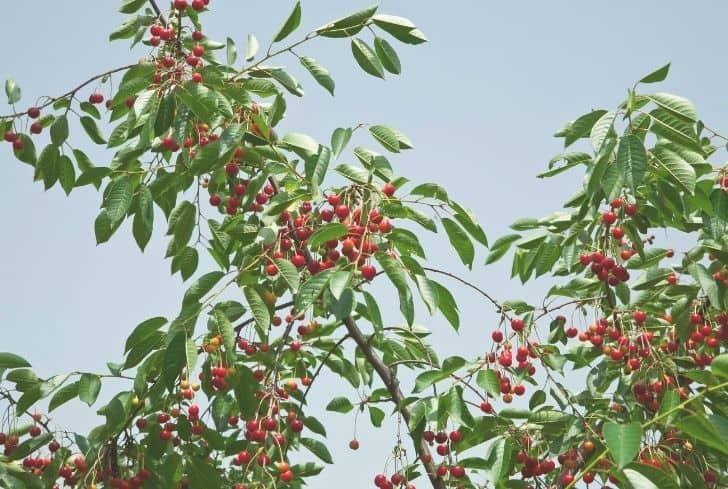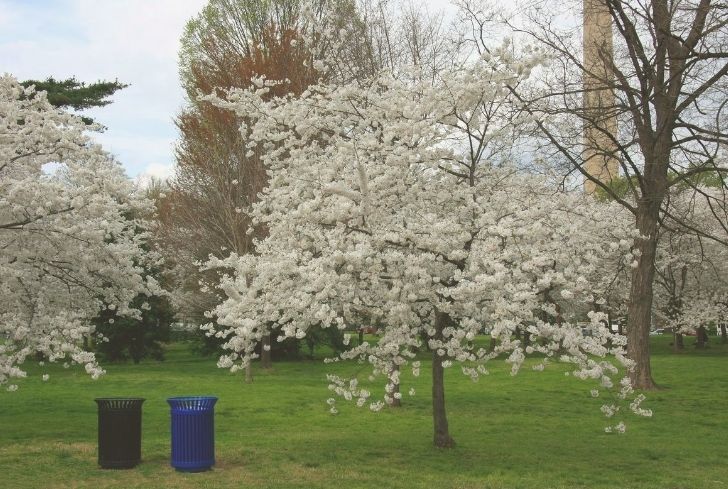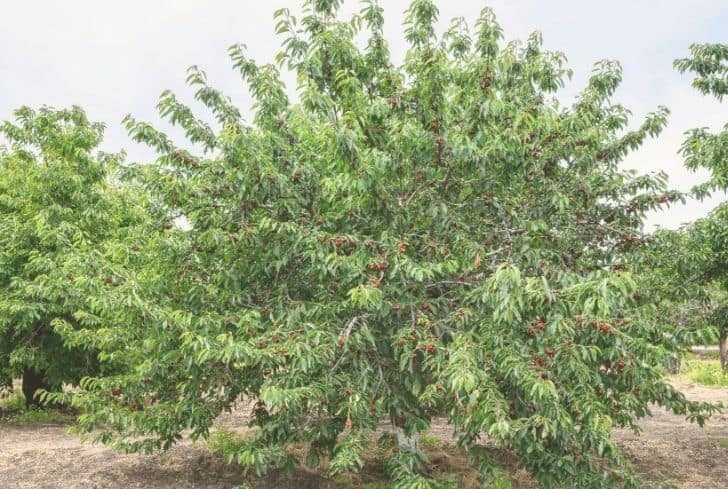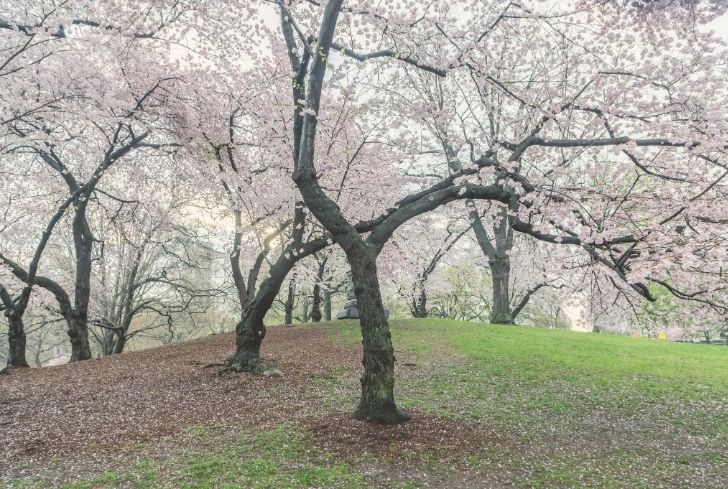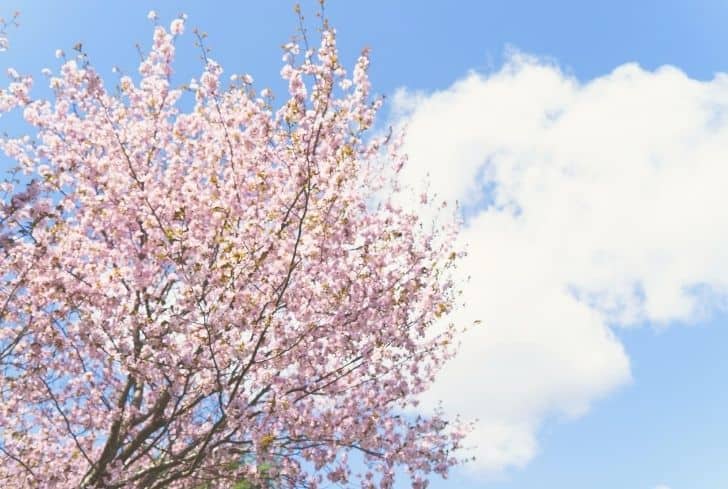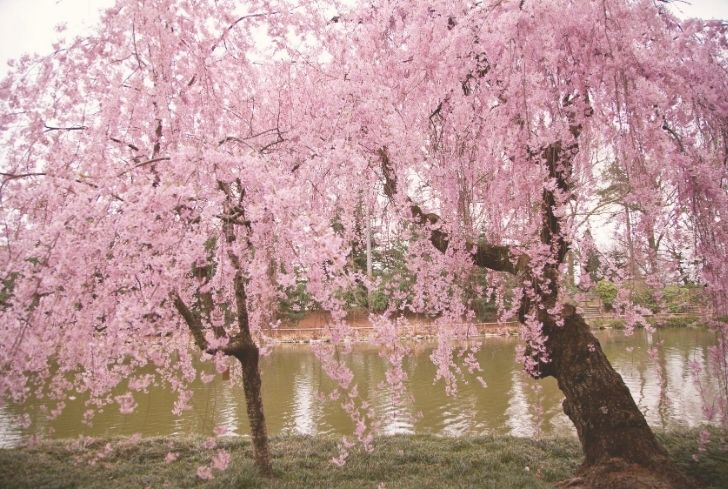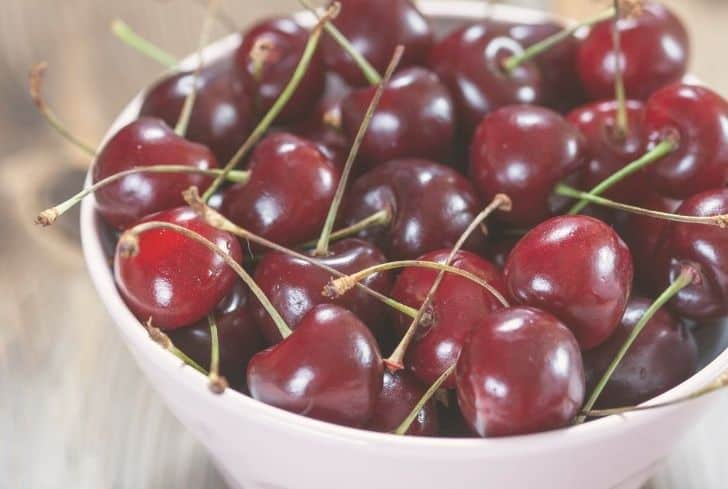Belonging to the Prunus genus, Cherry plants are best known for their beautiful and edible fruits. Native to the Northern Hemisphere, these plants are now grown almost everywhere.
There are about 10 to 12 recognized cherry plant species in parts of North America and almost the same number in European regions. However, these plants’ biggest and probably the highest population is in parts of Eastern Asia.
Today, Cherry plants are commercially produced for their fruits, usually frozen or canned.
Often used in sauces, these fruits can also be consumed raw. In fact, cherries are currently cultivated for consumption as fruits and come in three popular kinds — sweet, sour, and duke cherries.
The first two variants, sweet and sour cherries, are grown at a larger scale. However, the duke cherries (often a cross of the sweet and sour variants) are cultivated to a lesser extent.
Let’s look at the 13 most common types of cherry trees.
13 Most Common Types of Cherry Trees
Some of the most common types of cherry varieties include:
1. Sweet Cherry Tree
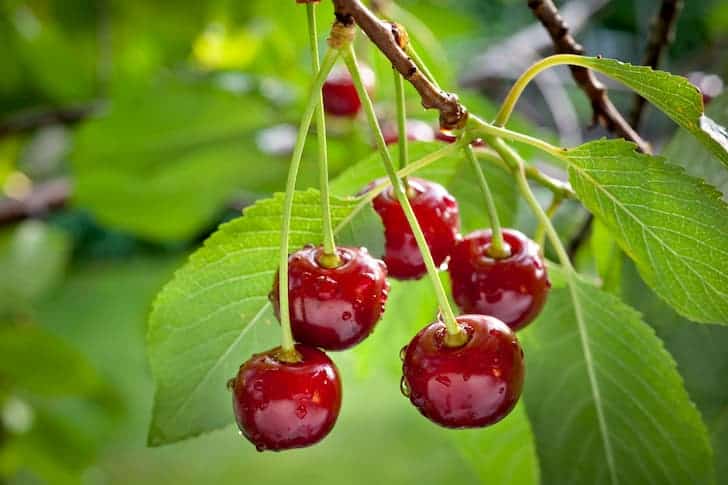
As you’d probably guess from the name, Sweet Cherries produce incredibly delectable cherries that may be best consumed as fresh fruit. Unlike other common variants of cherries often eaten as jams or pies, sweet cherries are best consumed raw. You will find multiple variants of these trees, with heights ranging from 18 feet to 35 feet.
Sweet cherry trees take the natural shape of a pyramid and are primarily grown as small and medium trees. Interestingly, in some instances, you can train the sweet cherry tree to fan out against a large wall or a fence.
The Sweet Cherry Trees are deciduous in nature, with their deep and beautiful green leaves developing during the spring months. By fall, the same leaves take bronze and golden hue.
The Sweet cherry tree is known to bloom early during spring with its exceptionally fragrant white flowers. They tend to bloom in tiny clusters with long branches, making way for beautiful clumps of bright, sweet cherries.
Usually, the size, structure, and hue of the sweet cherry fruit tend to vary depending on the type of species.
For instance, Stella Sweet Cherry produces the largest amount of fruits donning a deep and perfectly red color. The Black Tartarian species, on the other hand, produces fruits of similar size but with a unique orangish-red hue.
Thanks to hue, the cherries from these species appear more like tiny tomatoes than actual cherries in general.
Other variants like the Lapins, for instance, are self-pollinating. Due to this reason, you can plant them as single specimens and still expect hefty produce. Other species like Bing need to be cross-pollinated, where you need to plant several species of the Bing species nearby so that the tree can produce a wide range of sweet fruits.
While there isn’t any specific growing condition for the sweet cherry trees, they tend to thrive better in full sun with well-draining and completely fertile soil. While adding the soil, you also have to ensure that it is consistently moist. Almost all variants of sweet cherries require extensive rounds of low temperatures during the colder months to produce flowering buds.
For best results, you should ensure that your sweet cherry tree gets a minimum of 700 hours of cold temperature where the temperature is around or below 45 degrees F.
2. Vandalay Cherry Tree
This is yet another popular variant of the cherry tree that was known to be developed from cross-pollination between the Van and Stella variants of the tree. The Vandalay cherry tree was first created during the late nineties by Doctor Ghassem Tehrani. He named the tree after one of his favorite colleagues at the Horticultural Institute of Research, Ontario.
The Vandalay Cherries produce fruits with a deep reddish hue on the exteriors and wine-red colored flesh. They resemble kidneys and are incredibly sweet and delicious. You can eat them directly from the tree or extract the pulp for sweetmeats and pastries.
While the Vandalay cherries do not have any specific growing criteria and are fairly easy to maintain, you will need a clear idea about their required cold hardiness zones if you plan to cultivate them.
For the uninitiated, Vandalay cherries thrive best in US hardiness zones ranging from 5 to 9. So, if you are a gardener living in these zones, you might as well want to add this to your home orchard.
The cherries will start ripening by mid-July, like other sweet cherry variants. They’re self-pollinators, but for larger harvests, crossing them is the way to go. For cross-pollination, you can use multiple variants like Bing, Stella, Napoleon, and others.
3. Benton Cherry Tree
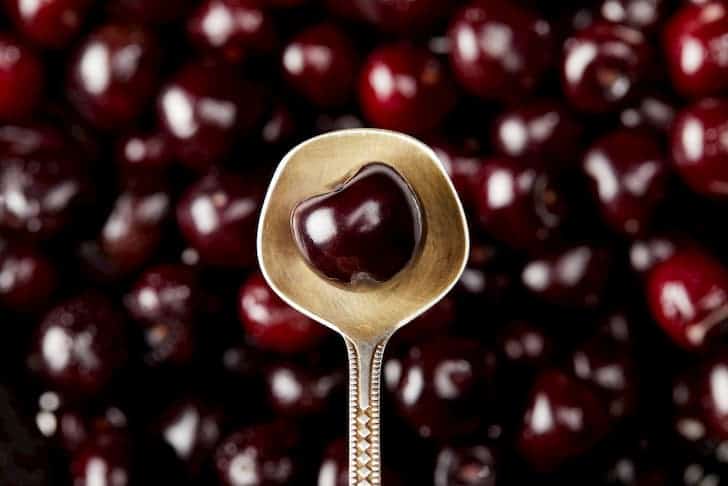
This is yet another excellent variant for cherry fanatics across the globe. Benton’s bear massive fruits with bright reddish hues that tend to ripen slightly earlier when compared to Bing cherries.
Unlike many other sweet cherry variants, the Benton cherry is also known to serve as a solid shield against multiple ailments, boosting overall health.
The variety is believed to be developed during the Washington State University Prosser Research Center trials. During these trials, the Stella and Beaulieu cherries were crossed to create the Benton cherry.
It’s from the Stella that Benton Cherry trees get their sweet flavor, with their early maturity coming as an inherited characteristic from the Beaulieu cherries.
The tree can grow fairly large, with branches spreading uprightly. The leaves are shaped like lances with relatively notched edges.
As for the skin, it’s bright red, while the fleshy part is pinkish red with semi-freestones. While the fruit is known to ripen mid-season, it is still a couple of weeks before the Bing starts ripening.
4. Black Tartarian Cherry Tree
Black Tartarian is a solid, large cherry plant that produces sweet and incredibly delicious cherries. The plant originates in Russia and was introduced in the US and parts of England in the late 1700s.
At one point, the Black Tartarian was known as the Large Black Heart owing to the shape and structure of the fruit, which is extremely deep and large with a dark reddish hue.
Black Tartarian is extremely popular among home gardeners because they abundantly produce sweet and pretty fruits. This happens during the summer months.
Even more, during this time, your entire garden will be transformed by the tree’s sweet aroma. This species of cherry can adapt to multiple types of soil and withstand drought better than its counterparts.
And the best part? The species is extremely easy to grow, even for those cultivating cherries for the first time.
5. Tibetian Cherry Tree
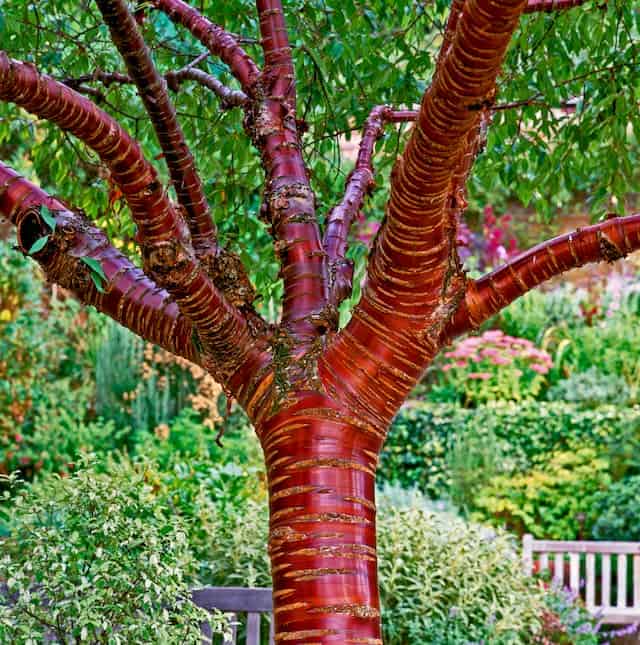
As you’d probably guess from the name, this cherry is native to parts of Tibet. It is a small and fairly deciduous plant with a perfectly round structure. In some instances, you can also grow it as a beautiful shrub. The tree is known for its unique and strikingly beautiful bark, which is glossy with a hue of copper.
This cherry is also extremely shiny and resembles silk threads hanging from a massive tree. You can witness the foliage and the fruits in the spring months. In winter months, the Tibetian Cherry prefers assuming an ornamental role.
6. Van Cherry Tree
Sweet, firm, and extremely juicy, this is yet another variant of cherry that is both delicious and beautiful. While many prefer eating it raw, Van cherries are best when combining them with cooked meals and desserts. Most commercial growers also use these cherries for preparing jams, sorbets, and a range of sauces.
If you plan to grow this plant at home, do it in the fall or spring months. The cherry needs proper and well-drained soil in addition to complete sunlight. While planting the saplings, make sure they stand a distance of 15 to 18 feet.
7. Lapins Cherry Tree
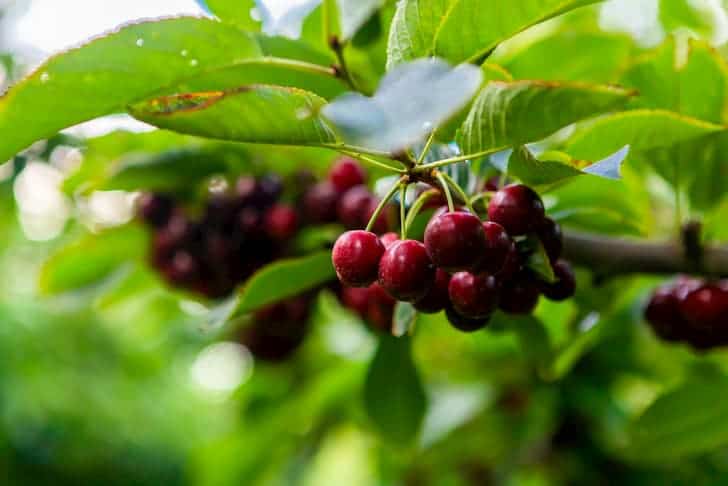
This is another popular cherry from the British Columbian region, developed by crossing the Van and Stella cherry. The Lapins Cherry Tree is known to come up with beautiful, sweet, and dark fruits that almost resemble Bing cherries. They have a diameter of around 2.5 centimeters, and their flesh tends to be firmer than Bing.
If you are cultivating this cherry at home, expect a round of harvest during late summer and spring. In winter, these cherries need around 800 to 900 hours to chill and work best in hardiness zones 5 to 9.
8. Yoshino Cherry Tree
Yoshino is a type of Hybrid cherry tree that was created by crossing two species of cherry trees. Originating in Japan, these trees are known for their beautiful fruits and upright branches.
The Yoshino cherry is deciduous in nature, and its flowers emerge before the foliage completely arrives. The blooms may be white or light pink with single or double clumps. These trees thrive best in US hardiness zones ranging from 5 to 8.
9. Sargent’s Cherry Tree
This is yet another deciduous tree known for its upright and almost rounded structure. The Sargent’s Cherry appears like an umbrella in the wild, producing stunning clumps of flowers in early spring.
Over time, the flowers make way for dark purplish fruits that may seem sour to the human taste buds.
10. Japanese Cherry Tree
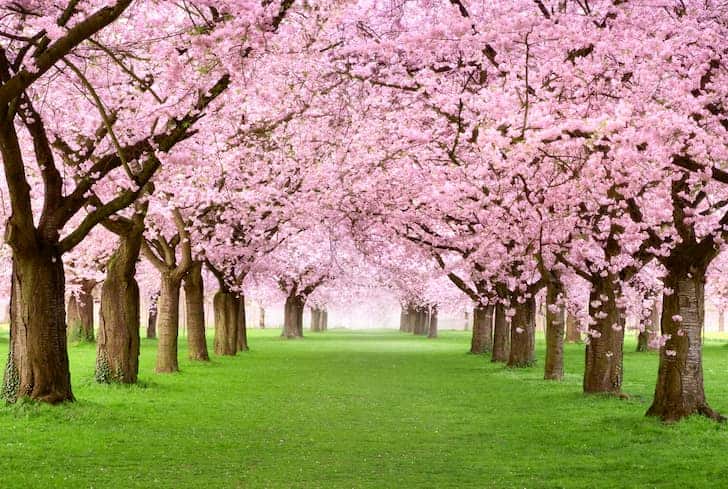
Popularly known as flowering cherries, the Japanese cherry is best known for its stunning display of blooms. The flowers are available in multiple shades of pink, violet, and white during the late summer and spring, with multiple clumps of flowers almost covering the branches.
The leaves are decorative and beautiful. They are usually light green in the summer months before finally assuming stunning shades of pink, orange, and red. While growing this plant, ensure it receives plenty of sunlight and the soil is moist and consistently well-drained.
11. Sweetheart Cherry Tree
Maturing in late fall with beautiful fruits, the Sweetheart cherry is perhaps best known for its fruit. The tree is an excellent fruiter, bearing red, succulent, and incredibly delicious cherries.
When growing at home, you must occasionally prune them to avoid invasion. Also, consider keeping the soil moist, as they do better in loamy and well-draining soils.
12. Higan Cherry Tree
This ornamental and deciduous cherry tree is known for its beautiful flowers, dense foliage, and unique shape.
The tree appears upright, almost rounded, with arched branches. Higans are known to bloom during late fall, with clusters of flowers covering their branches. The cherry species require moist soil and thrive best in US zones 6 to 8.
13. Attika Cherries Tree
Originating in the Czech Republic, these cherry trees were introduced to the US in the late 1800s. They bloom in late spring and thrive best in hardiness zones 5 to 7.
If you want to grow the plant at home, choose a location where it can get ample sunlight and moist soil. When in favorable conditions, the Attika Cherries can assume a height of up to 14 feet.
Well, these were some of the most common variants of cherries out there. Since most of them can be easily cultivated at home, wait no further and make your pick to cultivate cherries and consume them as and when you want to!
References:

